Mario Kart is a series of kart racing games and a spin-off Mario franchise developed and published by Nintendo. Players compete in go-kart races while using various power-up items. It features characters and courses mostly from the Mario series as well as other gaming franchises such as The Legend of Zelda, Animal Crossing, F-Zero, Excitebike, and Splatoon.

Mario Kart: Double Dash!! is a 2003 kart racing video game developed and published by Nintendo for the GameCube (GCN). This game is the fourth main entry in the Mario Kart series, succeeding Mario Kart: Super Circuit (2001). It is the first game in the series to use 3D polygon graphics for the racers, as opposed to sprites, after Mario Kart 64 (1996) only used polygons for the environments, and 2D sprites for the racers.

Pokémon Stadium 2, known in Japan as Pokémon Stadium Gold & Silver, is a strategy video game developed and published by Nintendo for the Nintendo 64. It features all 251 Pokémon from the first and second generations of the franchise. It was released in Japan on December 14, 2000, in North America on March 26, 2001, and in Europe on October 10, 2001. In Western regions it was titled Pokémon Stadium 2, as it was the second Stadium game to be released outside Japan, in which it was the third game in the series. It supports Dolby Surround sound.

F-Zero GX is a 2003 racing video game developed by Amusement Vision and published by Nintendo for the GameCube console. It runs on an enhanced version of the engine used in Super Monkey Ball. F-Zero AX, the arcade counterpart of GX, uses the Triforce arcade system board conceived from a business alliance between Nintendo, Namco and Sega. Published by Sega, it was released alongside GX in 2003.
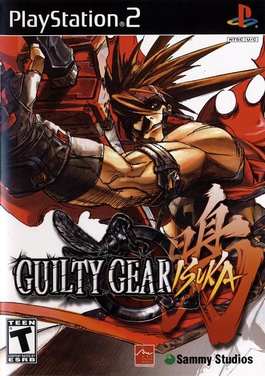
Guilty Gear Isuka is a 2D fighting video game developed by Arc System Works and published by Sammy Corporation. Announced by Arc in September, it was released on December 17, 2003, in Japanese arcades as the sixth installment of the Guilty Gear series. Later, the game was ported for a release on the PlayStation 2 (PS2), Xbox, and Windows in Japan. The PS2 version was brought to North America by Sammy, and, in Europe, the home console version was released by 505 Game Street and the PC version by Zoo Digital Publishing.
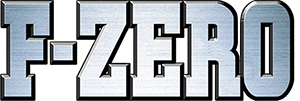
F-Zero is a series of futuristic racing games published by Nintendo, developed by Nintendo EAD and other third-party companies. The first game was released for the Super Famicom in Japan in 1990. Its success prompted Nintendo to create sequels on subsequent consoles.

Top Gear Rally is a 1997 racing video game developed by Boss Game Studios and released for the Nintendo 64. A follow-up to Kemco's original Top Gear game, it features a championship mode where a single player must complete six seasons of two to four races, as well as a multiplayer mode where two players may compete against each other via a split-screen display. The game's tracks combine both road and off-road surfaces and can be played in different weather conditions, including night, fog, rain, and snow. Players may customize their car with different tire grips and adjust its suspension stiffness and steering sensitivity. An option that allows players to custom paint their cars is also included.
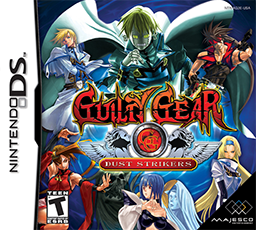
Guilty Gear: Dust Strikers, or Guilty Gear DS, is a fighting game of the Guilty Gear series for the Nintendo DS. Modeled after Guilty Gear Isuka, its gameplay allows up to four player fights. It was the first versus fighting game for the Nintendo DS to be released outside Japan.
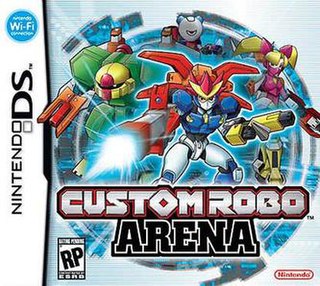
Custom Robo Arena, known in Japan as Gekitō Custom Robo, is an action role-playing game released for the Nintendo DS. It is the fifth game in Custom Robo series. The game was released October 2006 in Japan.

Pokémon Battle Revolution is a turn-based strategy video game in the Pokémon series developed by Genius Sonority and published by The Pokémon Company and Nintendo. It was released for the Wii on December 14, 2006, in Japan; on June 25, 2007, in North America; on November 22, 2007, in Australia, and on December 7, 2007, in Europe. Along with being the first Wii incarnation of the Pokémon video game franchise, it is also the first Wii game to use the Nintendo Wi-Fi Connection in North America and Japan and the second Wii game to wirelessly interact with the Nintendo DS handheld.

Custom Robo is an action role-playing video game developed by Noise and published by Nintendo for the Nintendo 64 in 1999 in Japan, and in 2006 for the iQue Player in China. It is the first game in the Custom Robo series. The game and its sequel Custom Robo V2 were re-released on the Nintendo Switch Online + Expansion Pack in Japan in July 2022.
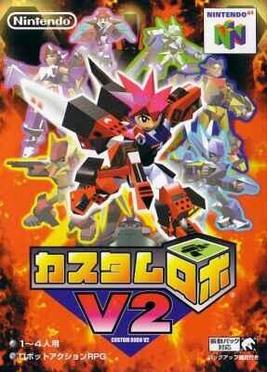
Custom Robo V2 is an action role playing video game developed by Noise and published by Nintendo. It was released for the Nintendo 64 in Japan on November 10, 2000. It was later re-released on February 19, 2008, for the Wii Virtual Console in Japan, and June 8, 2016, for the Wii U Virtual Console. It is the second title of the Custom Robo series, as well as the last of the series for the Nintendo 64. It is also the first title of the series to allow up to four players to play, instead of two players. The game was re-released along with its predecessor on the Nintendo Switch Online + Expansion Pack in Japan in July 2022.
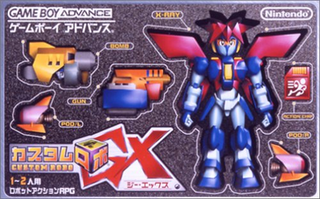
Custom Robo GX is an action role-playing game developed by Noise, and published by Nintendo for the Game Boy Advance on July 26, 2002, in Japan. The game stayed on Nintendo Power's future release list for a few years, until the release of the next title of the series, Custom Robo: Battle Revolution for the GameCube. NOISE also planned the sequel Custom Robo GX 2, but later dropped it in favor of Custom Robo Arena for the Nintendo DS. Nintendo previously planned to release it in late 2005 in Japan. Custom Robo GX is the third title of the Custom Robo series as well as the last Custom Robo title never released outside Japan.

Custom Robo: Battle Revolution, known in North America as Custom Robo, is an action role-playing game developed by Noise and published by Nintendo for the GameCube. It is the fourth title of the Custom Robo series, and the first title of the series released outside Japan.
Naruto: Clash of Ninja, released in Japan as Naruto: Gekitō Ninja Taisen!, is a series of 3D cel-shaded fighting games based on the manga and anime series Naruto by Masashi Kishimoto. They are developed by Eighting and published by D3 Publisher and Tomy. The series began with four GameCube games, with the first two available internationally and the last two released exclusively in Japan, before splitting into two parallel Wii-exclusive follow-up series: the Gekitō Ninja Taisen EX tetralogy released exclusively in Japan and its international counterpart, the Clash of Ninja: Revolution trilogy. The two Wii series share the same gameplay mechanics, but differ with respect to content and characters, with the international Revolution series being based on a localized version of the Naruto anime series. The first half of the original series and the entire Revolution trilogy are available in North America and Europe, the first two Revolution games are available in Australasia and all games in the series except the Revolution trilogy are available in Japan.

The Naruto: Ninja Council series, known in Japan as Naruto: Saikyō Ninja Daikesshū, is a series of action games based on the manga and anime series Naruto by Masashi Kishimoto. They are developed by Aspect Co. and published by Tomy in Japan and D3 Publisher in American. Various installments of the series have appeared on both Nintendo's Game Boy Advance and Nintendo DS, the first two games in the series available for the former while the rest are available on the latter.

NOISE Inc. is a Japanese video game development company that works in partnership with Nintendo, developing games for the Custom Robo series.
Puyo Puyo (ぷよぷよ), previously known as Puyo Pop outside Japan, is a series of tile-matching video games created by Compile. Sega has owned the franchise since 1998, with games after 2001 being developed by Sonic Team. Puyo Puyo was created as a spin-off franchise to Madō Monogatari, a series of first-person dungeon crawler role-playing games by Compile from which the Puyo Puyo characters originated. The series has sold over 9 million copies, including the Madō Monogatari games.
Mega Man Legacy Collection is a series of video game compilations based on Capcom's Mega Man franchise. Each compilation features several playable video games from one of the Mega Man sub-series and adds new gameplay features and bonus content such as concept artwork. These compilations were developed internally at Capcom and were released between 2015–2023 for Nintendo Switch, PlayStation 4, Windows, and Xbox One, with the exception of the original Legacy Collection which was developed by Digital Eclipse and also released on Nintendo 3DS.

Kirby Battle Royale is a brawler multiplayer video game in the Kirby series. Developed by HAL Laboratory and published by Nintendo, the game was released on the Nintendo 3DS handheld game console in Europe and Japan in November 2017, and in North America in January 2018.
















